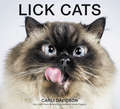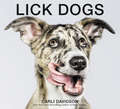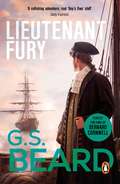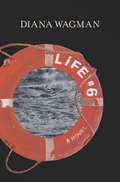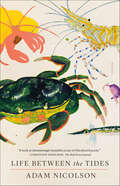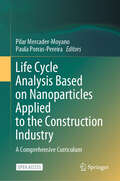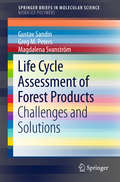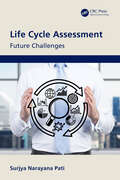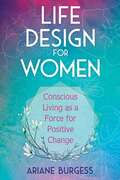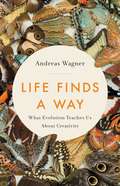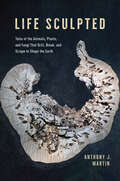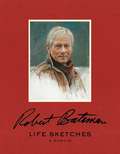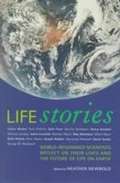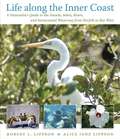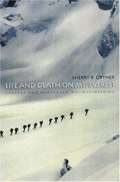- Table View
- List View
Lick Cats
by Carli DavidsonThe pet photographer and bestselling author of the Shake series presents more than sixty cute, cuddly, and charming cats caught in mid-lick in this delightfully funny full-color photography collection.Photographed in Carli Davidson’s recognizable style, Lick Cats includes more than 130 highly detailed, up-close portraits of cats at their most candid tongue-flicking moments. Showcasing slow-motion photography, Lick Cats follows the same layout as her previous books—each spread features two images of the same cat placed side by side to capture them in the action. The collection also includes a model roster listing the names, ages, and types of cats photographed, charming outtake images from the shoots, a short introduction about her process, and information about animal rescue to encourage fans to adopt a rescue cat.Filled with adorable and entertaining photographs, Lick Cats is a must for every cat fanatic as well as photography and animal lovers.
Lick Dogs
by Carli DavidsonThe pet photographer and bestselling author of the Shake series presents more than sixty cute, cuddly, and charming dogs caught in mid-lick in this delightfully funny full-color photography collection.Photographed in Carli Davidson’s recognizable style, Lick Dogs includes more than 130 highly detailed, up-close portraits of dogs at their most candid tongue-flicking moments. Showcasing slow-motion photography, Lick Dogs follows the same layout as her previous books—each spread features two images of the same dog placed side by side to capture them in the action. The collection also includes a model roster listing the names, ages, and types of canines photographed, charming outtake images from the shoots, a short introduction about her process, and information about animal rescue to encourage fans to adopt a rescue dog.Filled with adorable and entertaining photographs, Lick Dogs is a must for every dog and animal lover and photography fans.
Lies, Damned Lies, and Science: How to Sort Through the Noise Around Global Warming, the Latest Health Claims, and Other Scientific Controversies
by Sherry SeethalerDon't get hoodwinked: make sense of news. . . and make smarter decisions for yourself, your family, and the world! Objective, balanced techniques for thinking about everything from diet and drugs to climate change. Identifying and getting past the biases of politicians, lobbyists, marketers. . . and even some scientific and medical professionals. By scientist Dr. Sherry Seethaler, one of the world's most respected and innovative science educators.
Lieutenant Fury: a brilliantly engaging and rip-roaring naval adventure set during the French Revolutionary Wars that will keep you hooked!
by G.S. BeardIf you like Hornblower and Sharpe, you will love this all-action nautical page-turner from much loved author G.S.Beard. You'll feel as if you are in the midst of the action!'If you like sea stories, you will enjoy this, and even if you think you don't but enjoy things like Sharpe, it might just convert you' - HISTORICAL NOVELS REVIEW'Kept me spellbound' -- ***** Reader review'A fun, fast read' -- ***** Reader review'Excellent story and very exciting' -- ***** Reader review*************************************************************1793: the French Revolutionary Wars continue...When HMS Amazon is returning from an arduous duty in the Indian Ocean, she encounters a French frigate in the Atlantic which unexpectedly opens fire - a bloody sea battle ensues resulting in both triumph and personal tragedy for Acting Lieutenant John Fury.A battered Amazon puts into Gibraltar for repairs and newly promoted Fury finds he is to be transferred away from his home on the Amazon and set a new challenge: he will be the fifth lieutenant on the 74-gun-man of war Fortitude.The action never stops in Toulon, where Fury is posted and he eventually finds himself defending a prominent fort ashore as the Republican armies, inspired by a young artillery officer by the name of Napoleon Bonaparte, establish a brutal siege of the port. It is soon clear that Britain and her allies are going to be hard pressed to hold onto their prize.But Fury has more to lose than most - in the maelstrom of the siege he has met and fallen in love with a pretty French girl, Sophie Gourrier.Somehow, as the defence crumbles, he must rescue his men and Sophie from the doomed city.John Fury's adventures started in Mr Midshipman Fury - have you read it?
Life #6
by Diana WagmanCritically acclaimed author Diana Wagman brings us the suspenseful and emotionally exhilarating story of a woman facing death today, as well as thirty years ago. Fiona's marriage is crumbling, and she has recently been diagnosed with breast cancer. Caught up in a wave of memories as she faces her own mortality, Fiona recalls the previous times in her life when she nearly died, including a fateful boat trip with her former boyfriend, Luc. Fleeing her struggling marriage, Fiona rendezvous with Luc. In the process, she relives the harrowing boat trip from three decades earlier, which permanently altered her life. Now that Fiona desperately needs Luc to save her, will he be the man she remembers? Or will she discover heartbreak again?An adventurous and stirring tale inspired by Diana Wagman's own experience at sea, Life #6 explores the hope and folly of youth, how we react when we're pushed to the brink, the regrets of love lost, and the many ways we die and are renewed throughout our lives.ays we die and are renewed throughout our lives.Diana Wagman is the author of four novels and numerous short stories, essays, and reviews. Her second novel, Spontaneous, won the PEN West Award for Fiction. Her most recent novel, The Care and Feeding of Exotic Pets, was a Barnes & Noble Discover Great New Writers selection and was reviewed by the New York Times, Los Angeles Times, and Wall Street Journal, among many others. She lives in Los Angeles, California.
Life After Doom: Wisdom and Courage for a World Falling Apart
by Brian D. MclarenWhat does faith look like when cynicism seems more plausible?What does hope look like when hope seems irrational?What does love look like when hate becomes more popular?In recent years, author and activist Brian McLaren has sensed a widespread emotional shift among growing numbers of people. More and more friends, colleagues, students, and readers confess their sense of futility, their feelings of frustration bordering on despair. They feel that human civilization has passed certain tipping points and that a tide of doom is inexorably rising. This feeling creates a deep inner divide, a tension between a sincere and hopeful commitment to action for the common good on the one hand, and on the other, a feeling that no actions can prevent the arrival of an undesirable or even dystopian future.Life After Doom is a sober analysis of how things stand in relation to climate breakdown, and a deeply insightful exploration of the challenge of living well, maintaining resilience and growing in wisdom and love in the face of nations, ecosystems, economies, religions, and other institutions in disarray. Brian McLaren is the author of Faith After Doubt and Do I Stay Christian? and is a leading and authoritative voice at the intersection of religious faith and contemporary culture.'A book of rare wisdom, genuinely profound in depth and scope'DIANA BUTLER BASS
Life After Whale: The Amazing Ecosystem of a Whale Fall
by Lynn BrunelleFollow a blue whale&’s enormous body to the bottom of the ocean, where it sets the stage for a bustling new ecosystem to flourish.All living things must one day die, and Earth&’s largest creature, the majestic blue whale, is no exception. But in nature, death is never a true ending. When this whale closes her eyes for the last time in her 90-year life, a process known as whale fall is just beginning. Her body will float to the surface, then slowly sink through the deep; from inflated behemoth to clean-picked skeleton, it will offer food and shelter at each stage to a vast diversity of organisms, over the course of a century and beyond. Caldecott Medalist Jason Chin&’s astonishing artwork enriches and amplifies engaging, well-researched text by Bill Nye the Science Guy writer Lynn Brunelle. Young lovers of the macabre will relish each page of Life After Whale. Meanwhile, those grappling with the hard subject of death will take solace in this honest look at the circle of life, which closes on a young whale enjoying the same waves as her ancestor. Additional back pages offer further info and reading recommendations on whales, whale falls, and ecosystems.A Junior Library Guild Gold Standard Selection
Life Before the Drought (Routledge Library Editions: Water Resources)
by Earl ScottLittle attention had been paid to the realities of life in the Savanna-Sahel of West Africa before the drought of 1968-74, but this book, originally published in 1984 provides a set of authoritative accounts of the way in which the inhabitants cope with what outsiders perceive as a harsh environment. The peoples of the Savanna-Sahel are shown to be developers of strategies and technologies to manage their resources. Their understanding of the environment enables them to contribute substantially to any plans for economic and ecological recovery in the region. Their cooperative modes of life lead to greater social complexity and capacity for survival. Geographers, anthropologists and social historians should find the interdisciplinary human ecological approach of the book appealing. Development economists and rural planners will find the chapters on land-use patterns, and resource use particularly valuable.
Life Between the Tides
by Adam NicolsonAdam Nicolson explores the marine life inhabiting seashore rockpools with a scientist’s curiosity and a poet’s wonder in this beautifully illustrated book.The sea is not made of water. Creatures are its genes. Look down as you crouch over the shallows and you will find a periwinkle or a prawn, a claw-displaying crab or a cluster of anemones ready to meet you. No need for binoculars or special stalking skills: go to the rocks and the living will say hello.Inside each rock pool tucked into one of the infinite crevices of the tidal coastline lies a rippling, silent, unknowable universe. Below the stillness of the surface course different currents of endless motion—the ebb and flow of the tide, the steady forward propulsion of the passage of time, and the tiny lifetimes of the rock pool’s creatures, all of which coalesce into the grand narrative of evolution.In Life Between the Tides, Adam Nicolson investigates one of the most revelatory habitats on earth. Under his microscope, we see a prawn’s head become a medieval helmet and a group of “winkles” transform into a Dickensian social scene, with mollusks munching on Stilton and glancing at their pocket watches. Or, rather, is a winkle more like Achilles, an ancient hero, throwing himself toward death for the sake of glory? For Nicolson, who writes “with scientific rigor and a poet’s sense of wonder” (The American Scholar), the world of the rock pools is infinite and as intricate as our own.As Nicolson journeys between the tides, both in the pools he builds along the coast of Scotland and through the timeline of scientific discovery, he is accompanied by great thinkers—no one can escape the pull of the sea. We meet Virginia Woolf and her Waves; a young T. S. Eliot peering into his own rock pool in Massachusetts; even Nicolson’s father-in-law, a classical scholar who would hunt for amethysts along the shoreline, his mind on Heraclitus and the other philosophers of ancient Greece. And, of course, scientists populate the pages; not only their discoveries, but also their doubts and errors, their moments of quiet observation and their thrilling realizations.Everything is within the rock pools, where you can look beyond your own reflection and find the miraculous an inch beneath your nose. “The soul wants to be wet,” Heraclitus said in Ephesus twenty-five hundred years ago. This marvelous book demonstrates why it is so.Includes Color and Black-and-White Photographs
Life Cycle Analysis Based on Nanoparticles Applied to the Construction Industry: A Comprehensive Curriculum
by Pilar Mercader-Moyano Paula Porras-PereiraThis open access book describes in the recent years, there has been a notable upsurge in the use of nanomaterials, particularly within the construction and building sectors. The incorporation of nanoparticles introduces noteworthy changes in the physico-mechanical and physical–chemical characteristics of construction materials. Despite the acknowledged advantages of employing nanomaterials, uncertainties persist regarding their widespread adoption in development and applications, especially concerning potential environmental and human health implications. A crucial aspect in thoroughly assessing the environmental impacts of nanoproducts is the imperative quantification of effects on ecosystems and human health throughout the entire life cycle of these products. The indispensable utilization of a comprehensive tool, such as Life Cycle Assessment, becomes paramount in gaining a nuanced understanding of potential environmental and health challenges, thereby ensuring the environmental sustainability of nanomaterials. This academic publication endeavours to provide nanoproduct manufacturers, construction industry professionals, and waste managers with the necessary knowledge to comprehend the environmental and health impacts associated with the manufacturing, application, and disposal processes of nanoproducts used in the construction industry. This contribution aims to enhance their personal and professional development, consequently bolstering their employability at the European level. A thorough comprehension of potential releases throughout the entire life cycle of nanoproducts and their potential effects is imperative for ensuring the safe and sustainable utilization of these innovative materials. The application of life cycle thinking emerges as a pivotal component in appropriately evaluating the potential impacts associated with nanomaterial releases.
Life Cycle Assessment of Forest Products
by Gustav Sandin Greg M. Peters Magdalena SvanströmThis brief contains information on the reduction of environmental impact and explains how it is a key driver for the R&D of new forest products. The authors, experts in the field, describe how Life Cycle Assessment (LCA) is used to assess the environmental impact of such products, e. g. in order to guide R&D or attract investments. The authors describe the main challenges of carrying out LCAs on forest products, make recommendations for managing these challenges, and discuss future research needs. LCA case studies are used to illustrate the challenges, covering a variety of forest products: building components, biofuels, industrial chemicals, textile fibres and clothing. Described challenges include the planning of LCA studies (e. g. how can one use LCA in R&D?), the modelling of product systems (how can one handle multi-functionality and uncertainties related to waste handling and geographical location of future production?) and environmental impact (how can one assess water and land use impact, and the climate impact of biomass?).
Life Cycle Assessment: Future Challenges
by Surjya Narayana PatiThis book offers an itemized analysis of Life Cycle Assessment (LCA), for use in any processes, products, services, industries, organizations and so forth. Various challenges faced during applications of LCA, and its extension are discussed including their benefits. Further, the book provides practical examples of LCA in different core sectors, such as cement and construction. Each chapter functions as a stand-alone unit within the book and defines its individual role within the overall concept of LCA. Features: Covers Life Cycle Assessment (LCA) and future challenges including its practical applications as climate change tool. Connects life cycle management and LCA/environmental management. Explains benefits of LCA studies for both internal and external purpose in terms of various impact parameters. Identifies different raw materials or alternate energy mediums for changing inputs to reduce environmental impacts. Discusses extension of LCA concept like LCC, LCSA, SCLA, and OLCA. This book is aimed at professionals in all engineering areas and environmental studies.
Life Design for Women: Conscious Living as a Force for Positive Change
by Ariane BurgessA hands-on guide for designing a passionate, meaningful life that benefits you and the whole planet • Provides reflective visioning exercises and practical tools to help you examine your life as it is, the influences of your past, and the future you envision for yourself • Supports you to consciously weed out the thoughts and activities that get in the way of your authenticity and resonant heart • Helps you gain clarity in how to contribute more fully to a thriving regenerative future for both yourself and our world through your choices and actions When we choose to live more consciously, we benefit not only ourselves but all of life. In these turbulent times of transition and healing, women in particular are being called to reevaluate their lives and redirect their passion and actions toward purpose and meaning. By consciously redesigning our lives, we can reclaim our life force, connect more deeply with Nature and all life, and bring positive change to the world around us. Thus we become the true sovereign of our lives. Life Design for Women engages you in a simple, reflective visioning process to help you redesign your life to be more satisfying, meaningful, and aligned with your goals. Step by step, you will examine your life as it is, the influences of your past, and the future you envision for yourself. You will survey the domains of your life--from how you create &“home&” to your relationships with loved ones, food, your body, the Earth, and even Death. Applying the regenerative principles of sustainability to life design, author Ariane Burgess provides reflective exercises and practical tools to help you examine each of these domains, engage with natural systems, honor the feminine life force, and design your future. She shows how deep work in these areas gives you the resources needed to cut ties with the past and redirect your energy and passion toward your authentic purpose. You will learn to consciously weed out the thoughts and activities that get in the way of your resonant heart, take full responsibility for being the creator of your experiences, and make decisions that nurture your authentic self, rather than living your life through the dreams and fears of others. With this hands-on guide, you can reclaim your power through the Life Design process and choose to live more consciously. Gaining clarity on how you want to be, you bring well-being into your life and become a force for positive change, contributing to a thriving, regenerative future for life on Earth.
Life Finds a Way: What Evolution Teaches Us About Creativity
by Andreas WagnerHow the principles of biological innovation can help us overcome creative challenges in art, business, and scienceIn Life Finds a Way, biologist Andreas Wagner reveals the deep symmetry between innovation in biological evolution and human cultural creativity. Rarely is either a linear climb to perfection--instead, "progress" is typically marked by a sequence of peaks, plateaus, and pitfalls. For instance, in Picasso's forty-some iterations of Guernica, we see the same combination of small steps, incessant reshuffling, and large, almost reckless, leaps that characterize the way evolution transformed a dinosaur's grasping claw into a condor's soaring wing. By understanding these principles, we can also better realize our own creative potential to find new solutions to adversity.Ultimately, Life Finds a Way offers a new framework for the nature of creativity, enabling us to better adapt, grow, and change in art, business, or science--that is, in life.
Life In A Pond
by Carol K. LindeenText and photographs introduce ponds, and includes information on the plants found in ponds such as water lilies and cattails, and animals found in ponds such as fish, frogs, and ducks.
Life Rules
by Ellen LaconteCorporate capitalism has ravaged the planet the same way HIV ravages the human body, triggering a critical mass of cascading environmental, economic, social, and political crises. Economic and climate instability, collapsing ecosystems, peak fossil fuels, and devastating resource wars--if the Earth were a patient, her condition would be critical. Life Rules offers a comprehensive analysis of our present circumstances, combined with a holistic treatment protocol for restoring health to vulnerable human and natural communities. Predicting that Life will last, but if we don't make some fundamental changes, life as we know it--and a lot of us--won't, Life Rules identifies natural laws that have allowed non-human communities to thrive and prosper for several billion years, including: Local self-reliance Mutual interdependence Reliance on non-fossil sources of energy Resource conservation, sharing, and recycling Radically democratic self-organization and governance This sobering yet essentially optimistic manifesto is required reading for anyone concerned about our ability to live within Earth's means. A powerful tool for community transition and cultural transformation, Life Rules offers a solution to our global challenges that is at once authentically hopeful, deeply inspiring, and profoundly liberating. Ellen LaConte is acting director of the EarthWalk Alliance, a contributing editor to Green Horizon Magazine and The Ecozoic, a frequent talk show guest, and publisher of the Starting Point online newsletter. She has written two books about Helen and Scott Nearing, homesteaders and best-selling authors of Living the Good Life, and she is the author of the upcoming environmental novel Afton.
Life Sculpted: Tales of the Animals, Plants, and Fungi That Drill, Break, and Scrape to Shape the Earth
by Anthony J. Martin"There is much to love between this book’s covers. . . . There are many eureka moments in Life Sculpted—and some truly beautiful ones."—Eugenia Bone, Wall Street Journal Meet the menagerie of lifeforms that dig, crunch, bore, and otherwise reshape our planet. Did you know elephants dig ballroom-sized caves alongside volcanoes? Or that parrotfish chew coral reefs and poop sandy beaches? Or that our planet once hosted a five-ton dinosaur-crunching alligator cousin? In fact, almost since its fascinating start, life was boring. Billions of years ago bacteria, algae, and fungi began breaking down rocks in oceans, a role they still perform today. About a half-billion years ago, animal ancestors began drilling, scraping, gnawing, or breaking rocky seascapes. In turn, their descendants crunched through the materials of life itself—shells, wood, and bones. Today, such “bioeroders” continue to shape our planet—from the bacteria that devour our teeth to the mighty moon snail, always hunting for food, as evidenced by tiny snail-made boreholes in clams and other moon snails. There is no better guide to these lifeforms than Anthony J. Martin, a popular science author, paleontologist, and co-discoverer of the first known burrowing dinosaur. Following the crumbs of lichens, sponges, worms, clams, snails, octopi, barnacles, sea urchins, termites, beetles, fishes, dinosaurs, crocodilians, birds, elephants, and (of course) humans, Life Sculpted reveals how bioerosion expanded with the tree of life, becoming an essential part of how ecosystems function while reshaping the face of our planet. With vast knowledge and no small amount of whimsy, Martin uses paleontology, biology, and geology to reveal the awesome power of life’s chewing force. He provokes us to think deeply about the past and present of bioerosion, while also considering how knowledge of this history might aid us in mitigating and adapting to climate change in the future. Yes, Martin concedes, sometimes life can be hard—but life also makes everything less hard every day.
Life Sketches
by Robert BatemanFull of never-before-seen illustrations, Life Sketches is an inspiring and elegant portrait of Robert Bateman's life as an artist and of his belief that "Nature is an infinite source of reason, imagination, and invention."From one of Canada's most beloved painters comes an intimate, visually stunning memoir of the artist at work. Internationally acclaimed artist Robert Bateman has brought the natural world to vivid life with his unique perspective. His vast body of work--spanning species as large as the buffalo and as small as the mouse--has touched millions of hearts and minds, awakening a reverence for wildlife of all kinds. Bateman is perhaps best known for his gorgeous depictions of birds in flight and in repose, images that stir in the viewer a deep appreciation of colour, form and spirit. Life Sketches is a moving journey in both words and images that, for the first time, allows Bateman's fans full access into his creative process, detailing his singular artistic vision and the inspiration behind his iconic art. What emerges is a portrait of a young boy enchanted by the natural world around him and called to record it in his sketches and paintings. Bitten by wanderlust, Bateman travelled the world and documented his real life experiences in journals, sketches, and paintings. In Life Sketches, he recounts the evolution of his style from abstraction to realism and the events that have shaped his art into a vocation over many decades. And through it all, Bateman shows how his keen sensibilities extend beyond art, to a passion for conservation and relentless advocacy for the natural world that underpins an incredible artistic legacy. Join Robert Bateman on this personal guided tour through his life and art.
Life Stories: Well-Renowned Scientists Reflect on Their Lives and the Future of Life on Earth
by Heather Newbold"THIS BOOK IS FOR PEOPLE WHO WANT TO KNOW WHAT IS Happening to life on Earth-and to us. This knowledge is so important for our survival that I invited prominent scientists who investigate the planet's life-support system to tell their stories for our benefit. It is rare for scientists to discuss publicly their experiences, emotions, and beliefs because such expression is considered unscientific. This collection of personal and professional reflections is exceptional for its revelation of scientists' private lives and thoughts. Their profound understanding, appreciation, and reverence for life is inspirational and potentially transformative. We can experience it by following the development of their awareness, knowledge, and wisdom through their lives. These leading scientists began their careers in different scientific fields-in chemistry, nuclear physics, engineering, astronomy, and meteorology, as well as in the life sciences. In the forefront of their disciplines, they researched diverse aspects of the biosphere, yet reached convergent conclusions regarding the plight of our planet."
Life Story
by Virginia Lee BurtonEarth takes center stage in this updated version of Virginia Lee Burton's 1962 classic Life Story. Told through five acts, Burton's art and text tell the history of earth from beginning to present day. Readers will gain an in-depth understanding of the planet's history and their leading roles in it today. The book has been updated with cutting-edge science, including up-to-the-minute information on fossil records and the geologic principles. We are thrilled to provide this updated artistic and visionary work in time for the anniversary of Virginia Lee Burton's 100th birthday.
Life Underground: Tunnel into a World of Wildlife (DK Panorama)
by DKGo on an illustrated journey through nature&’s unseen habitats in this kids&’ book about life under the earth.Teeming with animal life, this book shows how life on Earth is interconnected and thriving in more places than you might think! Children aged 7-11 will be fascinated by what goes on under their feet, learning about the incredible diversity of life on planet Earth.Life Underground takes children on an illustrated journey into the world&’s most amazing underground habitats, from warm Arctic warrens to sandy desert dens. Explore the different communities of animals and plants that live under the Earth, from the succulent soil of an Australian forest to the hard ground at the icy north. Find out how animals and plants are adapted to their environment and how they interact with their surroundings and each other.This nature book for children offers: - Material that supports the science curriculum in schools up to Grades 3-5 – perfect for nature-loving children aged 7–11, and reluctant readers.- A look at Earth&’s major underground habitats and shows the animals that live there. - Beautifully detailed panoramic artworks show each underground scene teeming with life, with burrowing animals placed around the edge of the page for readers to find in the illustration.This illustrated guide lets children tunnel into a world of wildlife and explore different habitats, whilst teaching about different animal species and where they live. Details are drawn out from the artwork so that each habitat is easy to follow, making this the ideal nature book to have on your shelf.
Life Without Oil: Why We Must Shift to a New Energy Future
by John Wright Steve HallettHallett (botany and plant pathology, Purdue U. ), who is joined by John Wright, an energy and environmental journalist, contends that oil and natural gas supplies will wane by the end of the century and that society has failed to see this problem and act on it. He describes the history of the world in terms of energy use, how the petroleum interval of the last century fits into larger civilization, and how the rise of civilizations has been a story of human access to increasingly powerful sources of energy and that problems with access to energy have led to societal collapse. He examines problems that are likely to occur in different countries over the next half century, effects on the global economy, and what can be done about them it by considering nuclear power, reconnecting communities, focusing on sustainable agriculture, and recognizing that the laws of ecology override the economy. Annotation ©2011 Book News, Inc., Portland, OR (booknews.com)
Life along the Inner Coast
by Alice Jane Lippson Robert L. LippsonFor decades, marine scientists Robert and Alice Jane Lippson have traveled the rivers, backwaters, sounds, bays, lagoons, and inlets stretching from the Chesapeake Bay to the Florida Keys aboard their trawler, Odyssey. The culmination of their leisurely journeys, Life along the Inner Coast is a guide to the plants, animals, and habitats found in one of the most biologically diverse regions on the planet. It is a valuable resource for naturalists, students, and anyone who lives or vacations along the Atlantic inner coast.Southern Gateways Guide is a registered trademark of the University of North Carolina Press
Life and Death Decisions: Fighting to save lives from disaster, disease and destruction
by Dr Lachlan McIver***'Just brilliant. The book of the decade.' - Professor Tim Flannery, Former Australian of the Year 'An honest, powerful and riveting book that demonstrates Lachlan's courage in the face of the hardest of circumstances.' - Levison Wood, Award-winning author, explorer and photographer'Wow. A hugely important and enjoyable book that will restore your faith in humanity and what is possible... Deeply moving and at times tragic but never losing a sense of optimism or hope.' - Sir Jeremy Farrar, Director of the Wellcome TrustLachlan was sixteen when he found his father dead on the side of a dirt road in North Queensland, Australia. He had suffered a sudden heart attack and died alone. It was this tragedy that motivated Lachlan to train as a doctor specialising in providing medical care for people living in remote, resource-deprived locations. Lachlan's work with the World Health Organization and Médecins Sans Frontières has taken him to some of the world's most extreme environments, from the sinking islands of the Pacific to epidemics and war zones in the Middle East and sub-Saharan Africa. In this no-holds-barred memoir, Lachlan recounts his experiences treating patients ravaged by tropical diseases, managing war wounds with drug-resistant infections, delivering babies by the light of a head torch, dealing with the devastating effects of climate change and narrowly avoiding being kidnapped by militia in the Democratic Republic of the Congo. Tackling such impossible problems day in and day out inevitably takes a personal toll. Lachlan is ultimately forced to face his own battles with depression, alcohol abuse and bankruptcy.Life and Death Decisions is a deeply human look at the personal cost of our broken global health system and a vital call to action.
Life and Death on Mt. Everest: Sherpas and Himalayan Mountaineering
by Sherry B. OrtnerThe Sherpas were dead, two more victims of an attempt to scale Mt. Everest. Members of a French climbing expedition, sensitive perhaps about leaving the bodies where they could not be recovered, rolled them off a steep mountain face. One body, however, crashed to a stop near Sherpas on a separate expedition far below. They stared at the frozen corpse, stunned. They said nothing, but an American climber observing the scene interpreted their thoughts: Nobody would throw the body of a white climber off Mt. Everest. For more than a century, climbers from around the world have journeyed to test themselves on Everest's treacherous slopes, enlisting the expert aid of the Sherpas who live in the area. Drawing on years of field research in the Himalayas, renowned anthropologist Sherry Ortner presents a compelling account of the evolving relationship between the mountaineers and the Sherpas, a relationship of mutual dependence and cultural conflict played out in an environment of mortal risk. Ortner explores this relationship partly through gripping accounts of expeditions--often in the climbers' own words--ranging from nineteenth-century forays by the British through the historic ascent of Hillary and Tenzing to the disasters described in Jon Krakauer's Into Thin Air. She reveals the climbers, or "sahibs," to use the Sherpas' phrase, as countercultural romantics, seeking to transcend the vulgarity and materialism of modernity through the rigor and beauty of mountaineering. She shows how climbers' behavior toward the Sherpas has ranged from kindness to cruelty, from cultural sensitivity to derision. Ortner traces the political and economic factors that led the Sherpas to join expeditions and examines the impact of climbing on their traditional culture, religion, and identity. She examines Sherpas' attitude toward death, the implications of the shared masculinity of Sherpas and sahibs, and the relationship between Sherpas and the increasing number of women climbers. Ortner also tackles debates about whether the Sherpas have been "spoiled" by mountaineering and whether climbing itself has been spoiled by commercialism.
